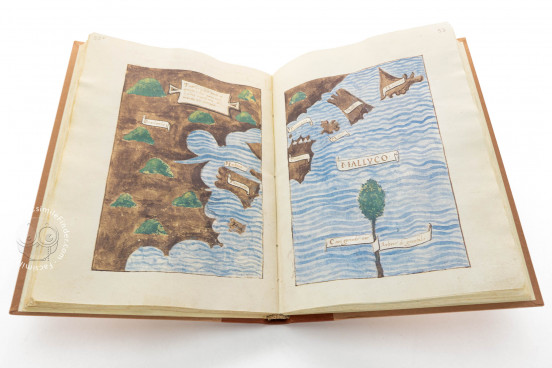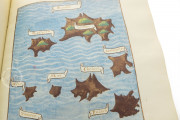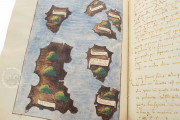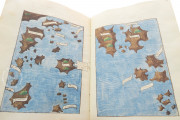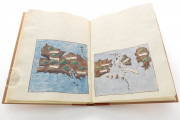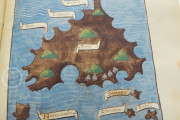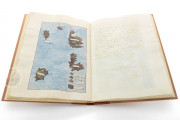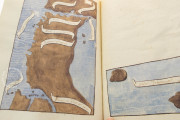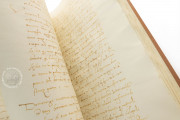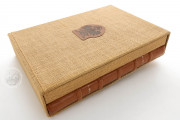The Voyage around the World manuscript in the Veneranda Biblioteca Ambrosiana is the only surviving Italian-language manuscript of Antonio Pigafetta's detailed eyewitness account of the first sea voyage to circumnavigate the globe. Created in 1523-1525, the manuscript dates from the years immediately following Pigafetta's return from the adventure. The text is history's chief source of information about the voyage. The manuscript features twenty maps, including three that extend across two facing pages.
Pigafetta was one of only eighteen men who completed the voyage (1519-1522) in search of a passage around or through South America to the Spice Islands of the Malucas in the Pacific Ocean led by the Portuguese seafarer Fernand de Magellan (d. 1521). Pigafetta's text is complemented by his maps charting many of the islands he visited.
Maps of Archipelagoes of the Pacific
The most famous of Pigafetta's maps—the first in the manuscript—charts the "Strait of Patagonia," known to history as the Strait of Magellan (fol. 14v). Maps of Pacific islands follow it, all rendered in color according to a fixed scheme: blue in a wavy pattern for the ocean, green for mountains, and brown for land, with unpainted parchment in the shape of dwellings for settlements.
In Search of Cloves
The map of the Mariana Islands, with the large island labeled the "Island of the Robbers," includes a representation of locals (despite their colorful European headgear) piloting a catamaran (fol. 16v). The goal of Magellan's voyage was Europe's source for cloves. Pigafetta reports that cloves grow on five islands, which he names. In one map of the Malucas, the chief source of the spice, he includes a representation of a clove tree (fols. 52v-53r). In another map of the Malucas, Pigafetta labels the island of Caphi as a place inhabited by pygmies (fols. 68v-69r).
A Curious Mind Revealed
Pigafetta records the hardships of the voyage, especially the nearly 100 uninterrupted days at sea, and the particulars of the Europeans' interactions with the indigenous peoples. He records a wealth of information about local customs and provides long vocabulary lists of local languages. With his keen interest in all he observed, he deftly meshes reportage of the European politics of the trip with adventure story and ethnography.
An Apograph Manuscript
The Ambrosiana manuscript is an apograph, a direct copy of the author's original. The text is written in elegant Cancelleresca, the formal cursive script of Italy at the time. Pigafetta's account of the voyage (fols. 1-80) is followed by a treatise on navigation (fols. 81-92) and thirty-two blank leaves (numbered 93-134 in the manuscript). The labels on the maps are in Gothic Hybrida.
Connection to the Knights of Rhodes
Pigafetta ultimately dedicated the book to the Grand Master of the Knights of Rhodes, Philippe Villiers de l'Isle-Adam (1464-1532), from whom he sought and received patronage for its publication. Although little is known of the circumstances surrounding the genesis of the Ambrosiana manuscript, its first recorded owner is one "chevalier de Forrete," who can be identified as either Philibert de la Forest or Jean de Foret, both Knights of Malta (as the Knights of Rhodes were known after making their headquarters on Malta in 1530). The manuscript is listed in seventeenth-century inventories of the Biblioteca Ambrosiana (now Veneranda Biblioteca Ambrosiana).
We have 1 facsimile edition of the manuscript "Ambrosiana Voyage around the World by Antonio Pigafetta": Noticia del Primer Viaje en Torno al Mundo facsimile edition, published by Ediciones Grial, 1998
Request Info / Price
